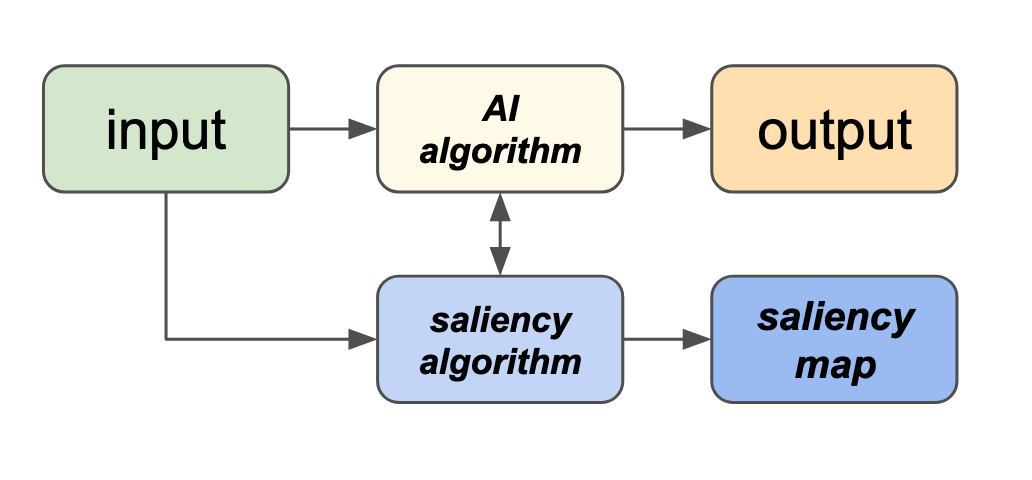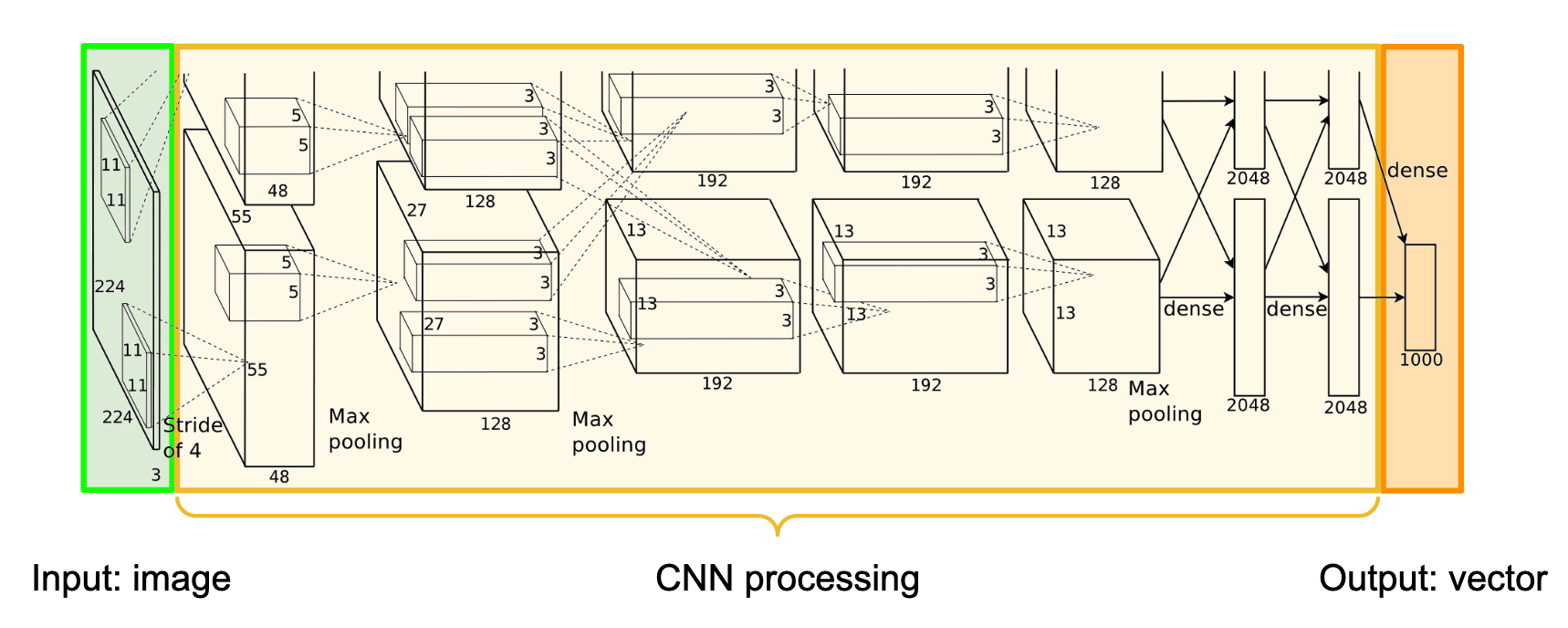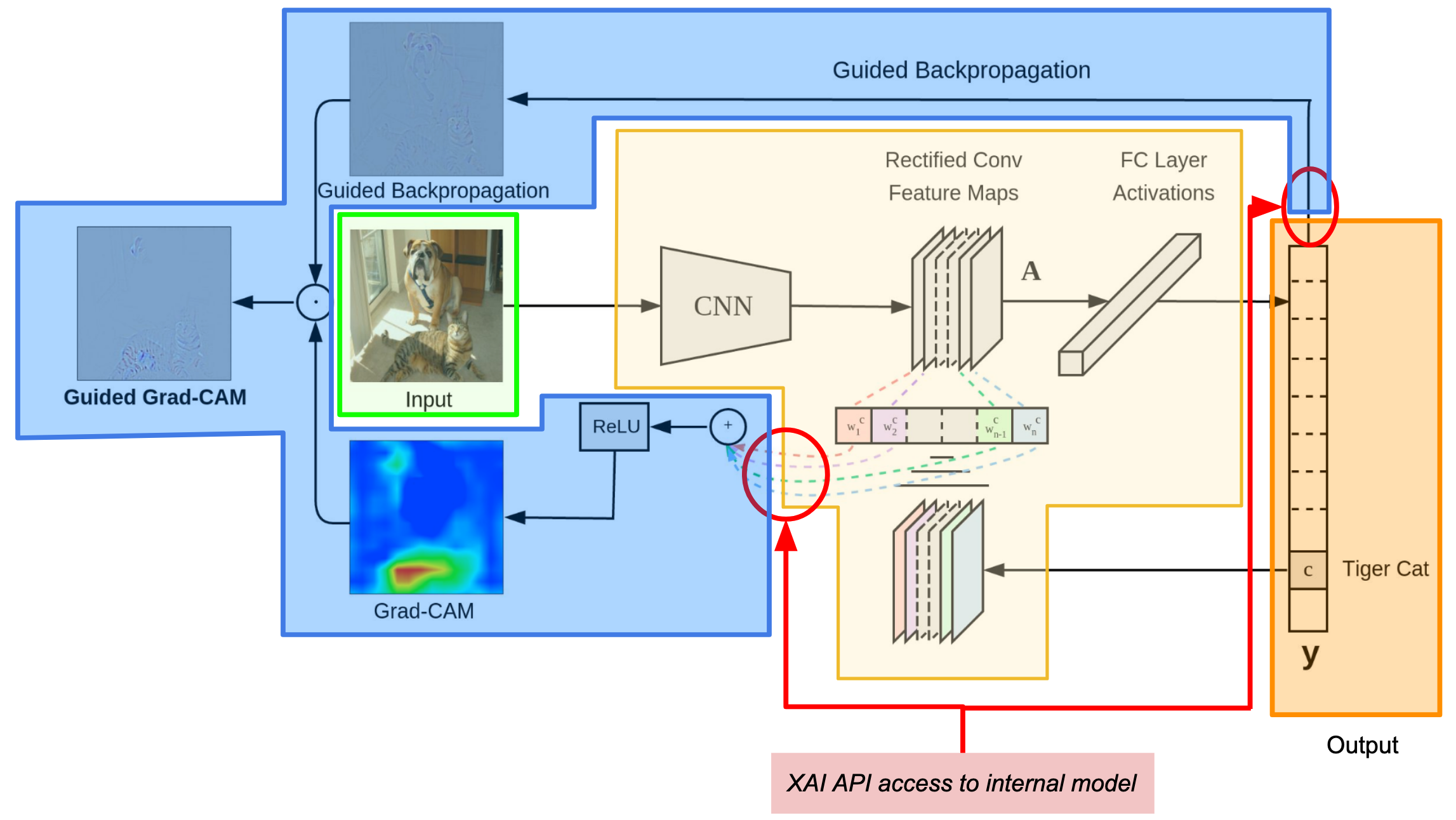Introduction
The XAITK-Saliency package implements a class of XAI algorithms known as saliency algorithms. The basic machine learning application pipeline is shown in Figure 1:

Figure 1: A basic AI pipeline.
In this scenario, an AI algorithm operates on an input (text, image, etc.) to produce some sort of output (classification, detection, etc.) Saliency algorithms build on this to produce visual explanations in the form of saliency maps as shown in Figure 2:

Figure 2: The AI pipeline augmented with a saliency algorithm.
At a high level, saliency maps are typically colored heatmaps applied to the input, highlighting regions that are somehow significant to the AI. Figure 3 shows sample saliency maps for text and images.

Figure 3: Sample saliency maps for text (left, from Tuckey et al.) and images (right, from Dong et al.)
Note
The XAITK-Saliency toolkit currently focuses on providing saliency maps for images.
Image Saliency Maps: An Intuitive Introduction
Figure 4 shows a deep learning pipeline for recognizing objects in images; pixels in the image (in green) are processed by the Convolutional Neural Network (CNN, in yellow) to produce the output (in orange). Here, the system has been trained to recognize 1000 object categories. Its output is a list of 1000 numbers, one for each object type; each number is between 0 and 1, representing the system’s estimate of whether or not that particular object is in the image.

Figure 4: Typical object recognition CNN architecture; the image (green, left) is processed left to right through the CNN (yellow) to produce an output vector (orange, right). Diagram from Krizhevsky et al.
This operation is “all or nothing” at both ends: the entire image must be processed, and the entire vector must be output. There is no mechanism by which a subset of the output can be traced back to a subset of the input. Yet it seems reasonable to ask questions such as:
The input image is a camel; why did the system give a higher likelihood to “horse” than “camel”?
The input image is a kitchen, but the system gave a high likelihood to “beach ball”. What parts of the image were responsible for this?
The input image contains two dogs, and the system gave a high likelihood for “dog”. How would this change if one of the dogs wasn’t in the image?
The input image contains a dog and a cat, and the system gave a high likelihood for “cat” but not “dog”. How will the system respond if the cat is removed?
At some level, these questions require a degree of introspection; the system must produce not only the output, but also some information about how the output was produced.
To avoid confusion, we need some definitions:
The AI algorithm, or AI, is the algorithm whose output we are trying to explain. An AI operates according to its AI model; contemporary AIs are built around CNNs such as in Figure 4, examples of other models include decision trees and support vector machines.
The Explainable AI system, or XAI, is the system we attach to the AI to generate explanations (as in Figure 2.) The XAI may itself use CNNs, but these details are typically hidden from the XAI user.
In order to answer questions such as the ones raised above, the XAI must have some way of interacting with the AI. There are two popular approaches to this:
The white box approach: the AI system is altered to open or expose its model. The XAI examines the state of the AI model as the AI generates its output, and uses this information to create the explanation.
The black box approach: the AI’s model is not exposed; instead, the XAI probes the AI by creating an additional set of input images which perturb or change the original input in some way. By comparing the original output to that for the related images, we can deduce certain aspects of the how the AI and its model behaves.
These are illustrated in Figure 5. Note how the AI algorithm is not available for inspection in the black box model.

Figure 5: White box vs. black box approaches to XAI. The white box approach has access to the AI model; the black box approach does not and instead repeatedly probes the AI with variations on the input image.
Note
The white box vs. black box distinction refers to using the AI model after it has been created; nothing is implied about how the model is constructed.
Let’s take a look at the pros and cons of these two approaches.
White Box Methods
The white box approach to XAI (Figure 5, left) exposes some (or all) of the internal state of the AI model; the explanation draws a connection between this exposed state and the AI’s output. Some AI methods are intrinsically introspective to the point where they are not so much “white box” as transparent:
In linear regression, the influence of the observations on the solution is an immediate consequence of the method.
In a decision tree, the output is directly computed by making the comparisons and branches encoded in the AI’s model.
An example of a white box explanation method for CNNs is Grad-CAM (paper, code), which exposes some (but not all) of the CNN layers to the explanation generation algorithm.

Figure 6: Grad-CAM architecture. Functional regions annotated to align with Figure 4: input in green, CNN architecture in yellow, output in orange. The explanation functionality is in blue; the APIs granting access to the model are circled in red. Figure from the Grad-CAM code repo.
In Grad-CAM, first the model computes its output per the typical processing flow: input (green), through the CNN (yellow), to the output (orange.) The explanation is created via an additional processing step that uses the output and feature maps from within the CNN (made available to the XAI through the red circles) to measure and visualize the activation of those regions associated with the output (orange).
Two aspects typical of white box methods are demonstrated here:
The explanation could not have been created from the output alone. In order to operate, the explanation algorithm (blue) required access to both the output and the CNN internal state.
The XAI implementation is tightly coupled to the AI’s CNN model architecture exposed by the API. Although the method may be general, any particular implementation will expect the AI’s CNN architecture to conform to the specifics of the API.
In general, pros and cons of white box approaches are:
Pros
A white box XAI can choose to leverage its tight coupling to the AI model to maximize the information available, at the sacrifice of generalization to other AI models.
A white box XAI accesses the actual AI model’s computation which generated the output. The explanation is derived directly from what the AI model computed about the input, in contrast to black box XAIs which can only indirectly compare the output to output from slightly different inputs.
A white box XAI is usually more computationally efficient, since it typically only requires a single forward / backward pass through the AI model. In Figure 5, the white box approach on the left interacts with the AI during its single processing run to produce the output; in comparison, black box methods (such as in Figure 5 on the right) typically run the AI network multiple times.
Cons
The flip side of tighter XAI integration to a specific AI model or class of models is loss of generality. An explanation technique that works for one model can be difficult to port to other AI models. Lack of generality can also make it harder to evaluate explanation algorithms across AI models.
It may be necessary to modify the AI model implementation to gain access to the internal state. Depending on the environment in which the AI was developed and delivered, this problem may be trivial or insurmountable.
Similarly, the white box XAI may require updating as the AI model evolves. Tight coupling introduces a dependency which must be managed, possibly increasing development costs.
Black Box Methods
Explanation options are correlated to how the related input are generated. pros: independent of the model; operates across all models; does not require access to the model implementation. cons: requires extra work to generate and process the related images; makes only indirect / differential observations about the original input / output pair; generally more resource intensive than white box.
XAITK-Saliency Map Algorithms
Discuss the provided XAITK-Saliency algorithms in terms of the above.